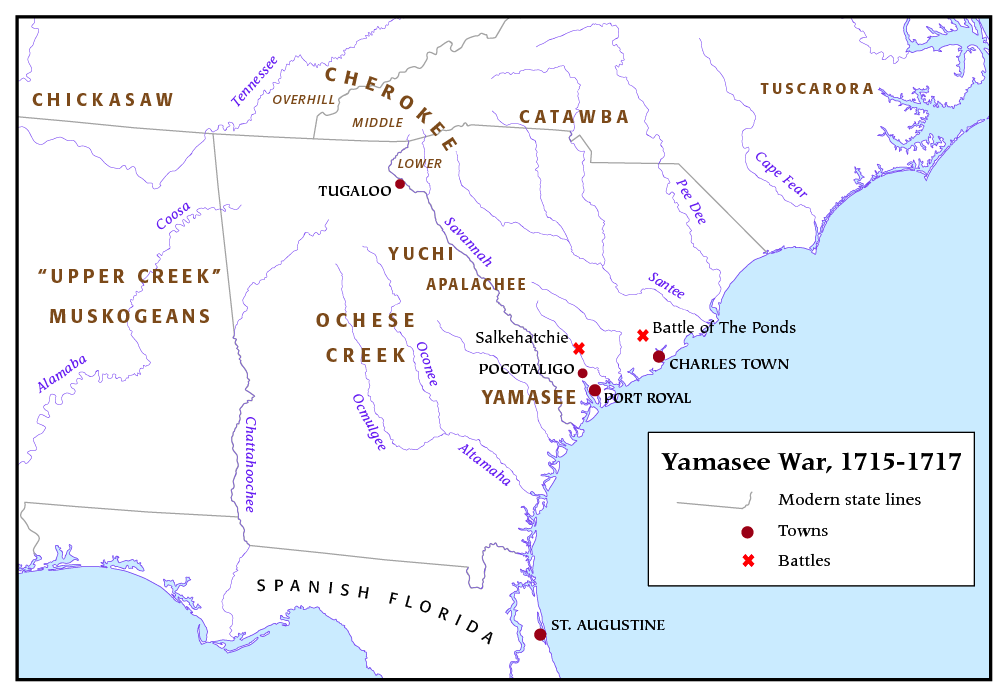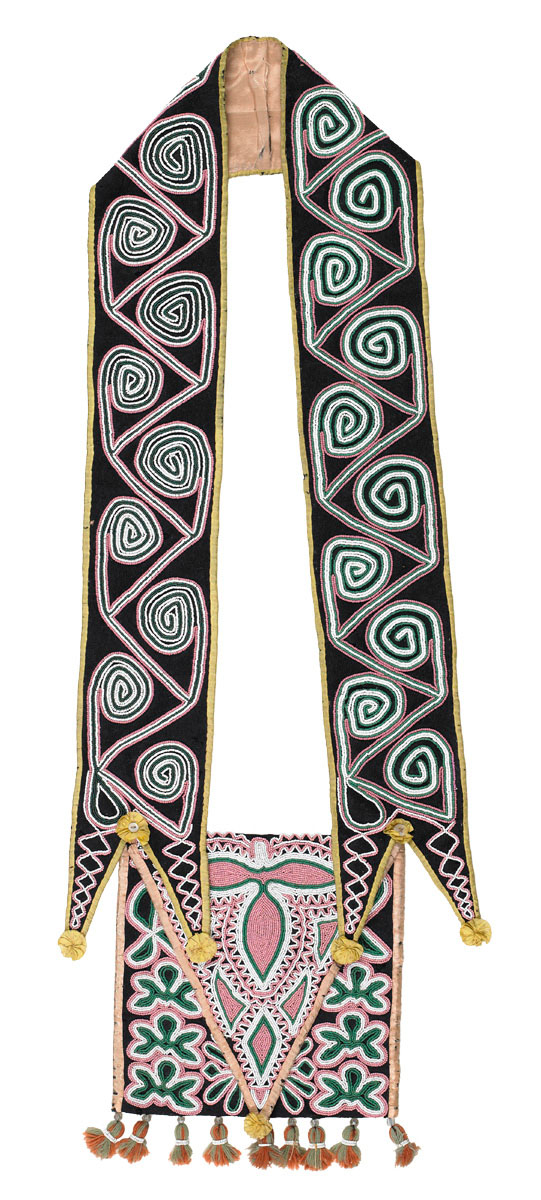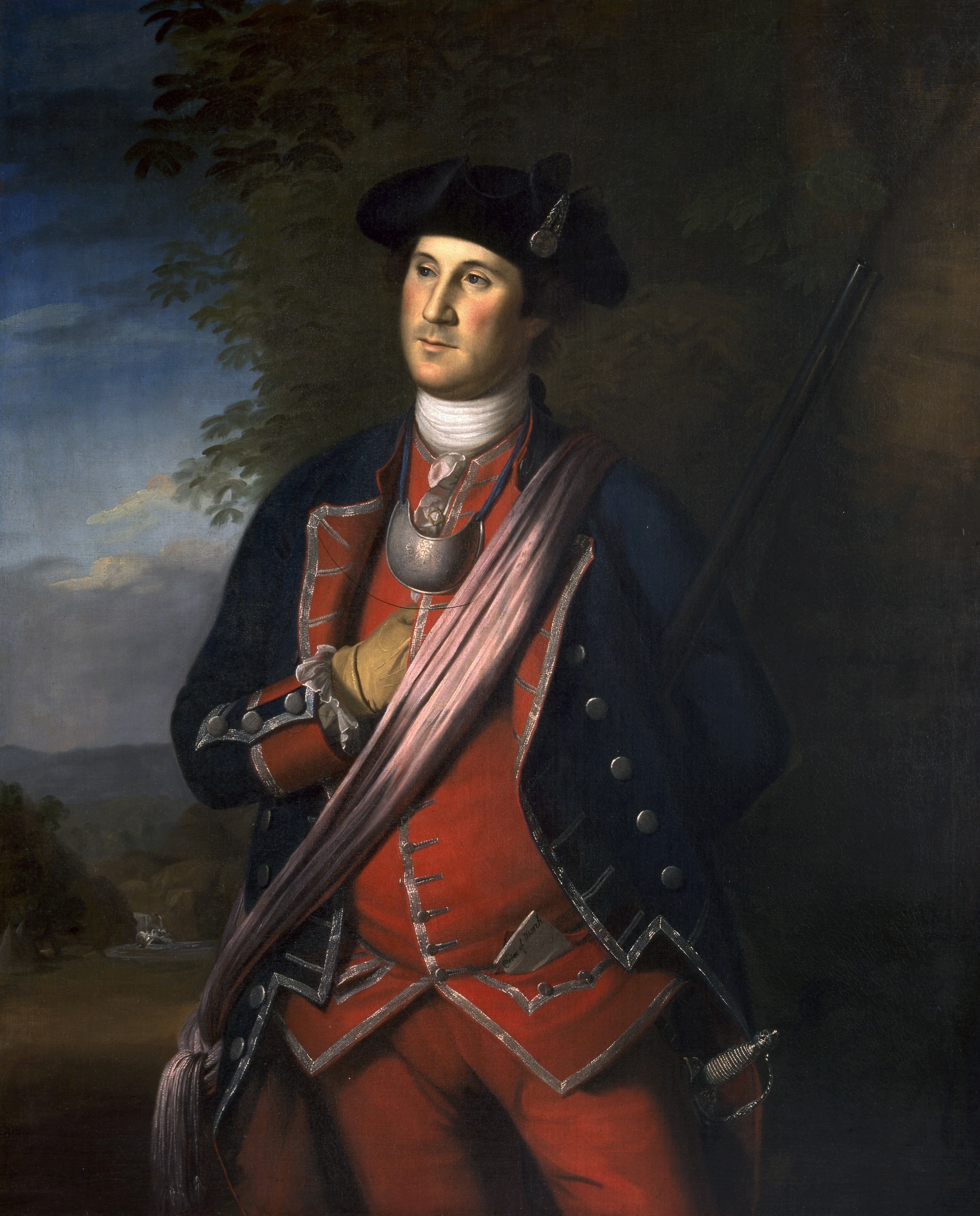|
Yamassee War
The Yamasee War (also spelled Yamassee or Yemassee) was a conflict fought in South Carolina from 1715 to 1717 between British settlers from the Province of Carolina and the Yamasee, who were supported by a number of allied Native American peoples, including the Muscogee, Cherokee, Catawba, Apalachee, Apalachicola, Yuchi, Savannah River Shawnee, Congaree, Waxhaw, Pee Dee, Cape Fear, Cheraw, and others. Some of the Native American groups played a minor role, while others launched attacks throughout South Carolina in an attempt to destroy the colony. Native Americans killed hundreds of colonists and destroyed many settlements, and they killed traders throughout the southeastern region. Colonists abandoned the frontiers and fled to Charles Town, where starvation set in as supplies ran low. The survival of the South Carolina colony was in question during 1715. The tide turned in early 1716 when the Cherokee sided with the colonists against the Creek, their traditional enemy ... [...More Info...] [...Related Items...] OR: [Wikipedia] [Google] [Baidu] |
American Indian Wars
The American Indian Wars, also known as the American Frontier Wars, and the Indian Wars, was a conflict initially fought by European colonization of the Americas, European colonial empires, the United States, and briefly the Confederate States of America and Republic of Texas against various Tribe (Native American), American Indian tribes in North America. These conflicts occurred from the time of the earliest colonial settlements in the 17th century until the end of the 19th century. The various wars resulted from a wide variety of factors, the most common being the desire of settlers and governments for Indian tribes' lands. The European powers and their colonies enlisted allied Indian tribes to help them conduct warfare against each other's colonial settlements. After the American Revolution, many conflicts were local to specific states or regions and frequently involved disputes over land use; some entailed cycles of violent reprisal. As American pioneer, American settlers s ... [...More Info...] [...Related Items...] OR: [Wikipedia] [Google] [Baidu] |
Yuchi
The Yuchi people are a Native American tribe based in Oklahoma, though their original homeland was in the southeastern United States. In the 16th century, the Yuchi lived in the eastern Tennessee River valley. By the late 17th century, they had migrated south to Alabama, Georgia, and South Carolina, settling near the Muscogee Creek people.Jackson 416 Some also migrated to the Florida panhandle. After suffering heavy losses from epidemic diseases and warfare in the 18th century, the remaining Yuchi bands were forcibly relocated to Indian Territory in the 1830s, alongside their allies, the Muscogee Creek. Today, the Yuchi primarily reside in northeastern Oklahoma, where many are enrolled citizens of the federally recognized Muscogee (Creek) Nation. They continue to maintain a distinct cultural identity, with some members still speaking the Yuchi language, a linguistic isolate. Name The term ''Yuchi'' translated to "over there sit/live" or "situated yonder." Their autonym, ... [...More Info...] [...Related Items...] OR: [Wikipedia] [Google] [Baidu] |
Spanish Florida
Spanish Florida () was the first major European land-claim and attempted settlement-area in northern America during the European Age of Discovery. ''La Florida'' formed part of the Captaincy General of Cuba in the Viceroyalty of New Spain, and the Spanish Empire during Spanish colonization of the Americas. While its boundaries were never clearly or formally defined, the territory was initially much larger than the present-day state of Florida, extending over much of what is now the southeastern United States, including all of present-day Florida plus portions of Georgia, South Carolina, North Carolina, Alabama, Mississippi, and the Florida Parishes, Florida Parishes of Louisiana. Spain based its claim to this vast area on several wide-ranging expeditions mounted during the 16th century. A number of missions, settlements, and small forts existed in the 16th and to a lesser extent in the 17th century; they were eventually abandoned due to pressure from the expanding English and Fre ... [...More Info...] [...Related Items...] OR: [Wikipedia] [Google] [Baidu] |
Louisiana (New France)
Louisiana or French Louisiana was a administrative divisions of France, district of New France. In 1682 the French explorer René-Robert Cavelier, Sieur de la Salle erected a cross near the mouth of the Mississippi River and claimed the whole of the drainage basin of the Mississippi River in the name of King Louis XIV, naming it "Louisiana". This land area stretched from the Great Lakes to the Gulf of Mexico and from the Appalachian Mountains to the Rocky Mountains. The area was under French control France in the early modern period, from 1682 to 1762 and in part French First Republic, from 1801 (nominally) to 1803. Louisiana included two regions, now known as Illinois Country, Upper Louisiana (), which began north of the Arkansas River, and ''Lower Louisiana'' (). The U.S. state of Louisiana is named for the historical region, although it is only a small part of the vast lands claimed by France. [...More Info...] [...Related Items...] OR: [Wikipedia] [Google] [Baidu] |
Indian Slave Trade
Slavery among Native Americans in the United States includes slavery by and enslavement of Native Americans roughly within what is currently the United States of America. Tribal territories and the slave trade ranged over present-day borders. Some Native American tribes held war captives as slaves prior to and during European colonization. Some Native Americans were captured and sold by others into slavery to Europeans, while others were captured and sold by Europeans themselves. In the late 18th and 19th centuries, a small number of tribes, such as the five so-called " civilized tribes", began increasing their holding of African-American slaves. European contact greatly influenced slavery as it existed among pre-contact Native Americans, particularly in scale. As they raided other tribes to capture slaves for sales to Europeans, they fell into destructive wars among themselves, and against Europeans. Traditions of slavery by Native Americans Many Native-American tr ... [...More Info...] [...Related Items...] OR: [Wikipedia] [Google] [Baidu] |
Muscogee Creek
The Muscogee, also known as the Mvskoke, Muscogee Creek or just Creek, and the Muscogee Creek Confederacy ( in the Muscogee language; English: ), are a group of related Indigenous peoples of the Southeastern WoodlandsTranscribed documents Sequoyah Research Center and the American Native Press Archives in the . Their historical homelands are in what now comprises southern , much of , western |
Colonial American Military History
Colonial American military history is the military record of the Thirteen Colonies from their founding to the American Revolution in 1775. Beginning when on August 29, 1643, the Plymouth Colony Court allowed & established a military discipline to be erected and maintained. Rangers Rangers in North America served in the 17th and 18th-century wars between colonists and Native American tribes. Regular soldiers were not accustomed to frontier warfare and so Ranger companies were developed. Rangers were full-time soldiers employed by colonial governments to patrol between fixed frontier fortifications in reconnaissance, providing early warning of raids. In offensive operations, they were scouts and guides, locating villages and other targets for task forces drawn from the militia or other colonial troops. The father of American ranging is Colonel Benjamin Church (c. 1639–1718).John Grenier. The First Way of War: American War Making on the Frontier. Cambridge University Press. 20 ... [...More Info...] [...Related Items...] OR: [Wikipedia] [Google] [Baidu] |
Charleston, South Carolina
Charleston is the List of municipalities in South Carolina, most populous city in the U.S. state of South Carolina. The city lies just south of the geographical midpoint of South Carolina's coastline on Charleston Harbor, an inlet of the Atlantic Ocean formed by the confluence of the Ashley River, Ashley, Cooper River (South Carolina), Cooper, and Wando River, Wando rivers. Charleston had a population of 150,227 at the 2020 United States census, 2020 census. The population of the Charleston metropolitan area, South Carolina, Charleston metropolitan area, comprising Berkeley County, South Carolina, Berkeley, Charleston County, South Carolina, Charleston, and Dorchester County, South Carolina, Dorchester counties, was estimated to be 849,417 in 2023. It ranks as the South Carolina statistical areas, third-most populous metropolitan area in the state and the Metropolitan statistical area, 71st-most populous in the U.S. It is the county seat of Charleston County, South Carolina, Ch ... [...More Info...] [...Related Items...] OR: [Wikipedia] [Google] [Baidu] |
Cheraw People
The Cheraw people, also known as the Saraw or Saura,Sebeok, Thomas Albert''Native Languages of the Americas, Volume 2.''Plenum Press, 1977: 251. were a Siouan-speaking tribe of Indigenous people of the Southeastern Woodlands,Swanton''The Indians of the Southeastern United States'' p. 109. in the Piedmont area of North Carolina near the Sauratown Mountains, east of Pilot Mountain and north of the Yadkin River. They lived in villages near the Catawba River.Rudes et al., "Catawba and Neighboring Groups", p. 310 Their first European and African contact was with the Hernando De Soto Expedition at the site of Joara in 1540. The early English explorer John Lawson included them in the larger eastern-Siouan confederacy, which he called "the Esaw Nation."''Handbook of the American Indian North of Mexico'', 1906 After attacks in the late 17th century and early 18th century, they moved to the southeast around the Pee Dee River, where the Cheraw name became more widely used. They became ex ... [...More Info...] [...Related Items...] OR: [Wikipedia] [Google] [Baidu] |
Cape Fear Indians
The Cape Fear Indians were a small, coastal tribe of Native Americans who lived on the Cape Fear River in North Carolina (now Carolina Beach State Park). Name and language The autonym of the Cape Fear Indians may have been Daw-hee. Their name for the area was Chicora. Of their villages, only one, Necoes, is known by name. The colonists noted Necoes as about 20 miles from the mouth of the Cape Fear River, in present-day Brunswick County.Swanton, John R. (1952; reprinted 2003). ''The Indian Tribes of North America'', p. 75. Baltimore, MD: Genealogical Publishing Company. Their language is unknown and may have been a Siouan language. History Smallpox spread from Spanish colonies in Florida to the Carolinas in the 16th century. The population of the Cape Fear Indians was estimated to be 1,000 in 1600. A colonial census in 1715 recorded that they numbered 206. British colonist William Hilton observed 100 Indians at Cape Fear in 1662. One Indian individual sold to Hilton Cape Fear ... [...More Info...] [...Related Items...] OR: [Wikipedia] [Google] [Baidu] |
Pee Dee People
The Pedee people, also Pee Dee and Peedee, were a historic Native American tribe of the Southeastern United States. Historically, their population has been concentrated in the Piedmont of present-day South Carolina. It is believed that in the 17th and 18th centuries, English colonists named the Pee Dee River and the Pee Dee region of South Carolina for the tribe. Today four state-recognized tribes, one state-recognized group, and several unrecognized groups claim descent from the historic Pedee people. Presently none of these organizations are recognized by the Bureau of Indian Affairs, with the Catawba Indian Nation being the only federally recognized tribe within South Carolina. Etymology The precise meaning of the name ''Pedee'' is unknown. The name has many variations, having been alternatively spelled as ''Pee Dee'', ''PeeDee'', ''Peedee'', ''Peedees'', ''Peadea'', and ''Pidee''. In early Spanish accounts the name is rendered, ''Vehidi''. There has been contention among ... [...More Info...] [...Related Items...] OR: [Wikipedia] [Google] [Baidu] |







